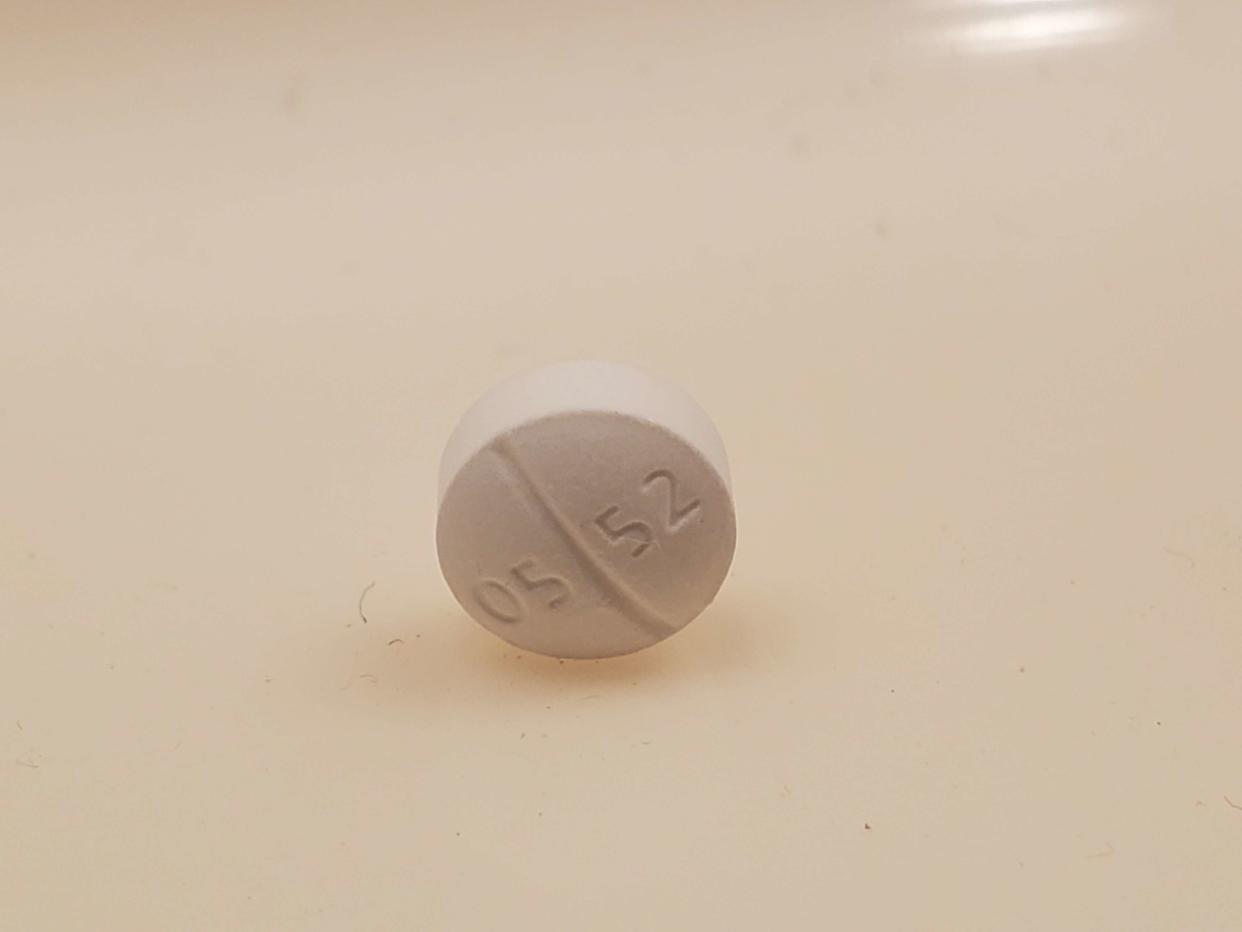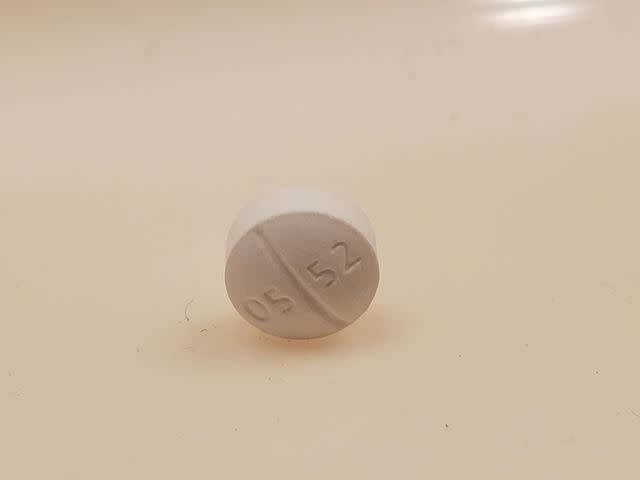Tramadol vs. Oxycodone: What Are the Differences?

Getty Images / Smith Collection/Gado / Contributor
Medically reviewed by David Snyder, PharmD, BCPP
Tramadol (available under brand names such as Conzip and Ryzolt) and oxycodone (brand names include OxyContin and Xtampza ER) are opioid medications used for pain relief.
The main difference between tramadol and oxycodone is the difference in potency, or the amount of drug needed to produce its effects.
Tramadol is a weak opioid with weaker opioid-like properties than a potent opioid medication, such as oxycodone. Although both are controlled substances, meaning they have a potential for dependence and addiction, oxycodone has a higher risk of addiction and abuse.
This article will cover the similarities and differences between tramadol and oxycodone, including uses, safety information, how well they work, and more.

Getty Images / Smith Collection/Gado / Contributor
What Are the Differences Between Tramadol and Oxycodone?
The main difference between tramadol and oxycodone is the potency.
Tramadol is a weak opioid with a similar effect and structure to morphine with weaker opioid-like properties than a potent opioid medication, such as oxycodone. Oxycodone has a higher risk for addiction and abuse.
This is why the Food and Drug Administration (FDA) classified oxycodone as a Schedule II controlled substance which is a high-risk classification for abuse and dependence compared to Schedule IV for tramadol.
These medications work differently, too, which accounts for their differences in potency. Oxycodone is an active compound that directly causes pain relief, while tramadol acts as a prodrug. A prodrug is an inactive product that is processed in the body to reach an active form to ultimately relieve pain.
What Is Tramadol Used For?
Tramadol is a centrally acting pain reliever used to treat moderate to moderately severe pain in adults. It is prescribed for short-term pain relief and is only used when other non-opioid agents are ineffective in your pain management plan.
This medication comes as a tablet in a few strengths, including 50 milligrams (mg) and 100 mg. Tramadol also comes in extended-release formulations in 100 mg, 200 mg, and 300 mg.
Side Effects of Tramadol
Common side effects of tramadol include:
Nausea
Dry mouth
Dizziness
Drowsiness
Sedation
Headache
Severe side effects may include:
Seizures
Respiratory depression
Addiction
Long-term use of tramadol can also lead to liver and kidney damage.
What Is Oxycodone Used For?
Oxycodone is indicated for moderate to severe pain management for either short-acting pain or when a continuous analgesic is needed.
Oxycodone is taken orally (by mouth). The oral dosage form of oxycodone is available as tablets, capsules, and a solution. Oral oxycodone is available in immediate, extended, and controlled-release formulations.
The main difference is that the ER version relieves severe pain in individuals needing pain relief around the clock, while immediate-release oxycodone is used for short-term pain.
You should only be prescribed 60 mg or 80 mg tablets, a single dose greater than 40 mg, or any total daily dose greater than 80 mg if you demonstrated tolerance to an opioid of comparable potency in the past.
Side Effects of Oxycodone
The most common side effects are:
Constipation
Dizziness
Dry mouth
Headache
Sweating
Vomiting and nausea
Severe side effects may include:
Respiratory depression
Addiction
Low blood pressure
Slow heart rate
Liver injury
Long-term use of oxycodone can cause mental or physical dependence. However, people with continuous pain may still use oxycodone for pain control.
Is Tramadol or Oxycodone More Effective for Pain?
Tramadol and oxycodone are strong pain medications that work in different ways to reduce pain.
Although tramadol is not as strong as oxycodone, it can still provide significant relief for moderate to severe pain, such as acute pain like surgery or injury, or chronic pain conditions like arthritis.
Oxycodone, on the other hand, is a much stronger medication that provides fast and powerful pain relief.
Your healthcare provider will decide which medication to prescribe based on the type and severity of the pain.
Safety Warnings
Tramadol and oxycodone are both effective pain relievers, but it is important to understand the serious safety risks associated with taking these medications, which include:
Abuse/misuse: Studies show that tramadol and oxycodone have high abuse rates among users.
Overdose: Both tramadol and oxycodone have been associated with a high risk of overdose, especially when misused or used in combination with other opioids or sedatives.
FDA warnings: The FDA has warned about the potential risks of tramadol and oxycodone, including respiratory depression, addiction, and withdrawal symptoms.
FDA Warnings for Tramadol
The FDA has issued the following boxed warnings regarding tramadol.
Seizures
Seizure risk has been reported in treatment with tramadol at the recommended dose, and risk will increase when taken above the recommended dose.
Seizure risk can also increase when taking tramadol with selective serotonin reuptake inhibitors (SSRIs), tricyclic antidepressants (TCAs), other opioids, monoamine oxidase inhibitors (MAOIs), neuroleptics, and other drugs that reduce the seizure threshold. Naloxone can also increase the risk of seizures when administered for a tramadol overdose.
Convulsion risk can also increase in people with:
A history of seizures or epilepsy
Head trauma
Central nervous system (CNS) infections
Drug or alcohol withdrawal
Metabolic disorders
Suicide Risk
Tramadol can Increase the risk of suicide. It should not be prescribed to people with an increased risk of suicide or addiction.
Serotonin Syndrome
Tramadol can also increase the risk of serotonin syndrome, a life-threatening condition that presents as mild diarrhea or nausea to severe symptoms of fever and seizures. Other antidepressant agents, including SSRIs, TCAs, MAOIs, and serotonin-norepinephrine reuptake inhibitors (SNRIs), should be avoided to prevent the risk of serotonin syndrome.
Respiratory Depression
Taking tramadol can lead to respiratory depression, especially when starting treatment or after increasing the dose. Respiratory depression can cause symptoms like shortness of breath, fast breathing, fast heart rate, and a bluish tone to the skin or lips.
FDA Warnings for Oxycodone
FDA warnings for oxycodone include:
Overdose: Swallow oxycodone tablets whole; do not crush them. This prevents rapid absorption and a potentially fatal dose.
Respiratory depression: Dosages should be limited to the minimum required.
Increased risk of drug addiction and abuse: Oxycodone is a Schedule II controlled substance. There is a risk of addiction even at recommended dosages if the medication is misused or abused.
Risks from taking it with benzodiazepines or other CNS depressants: Oxycodone can have an additive effect if taken with alcohol and other opioids, which may result in sedation, respiratory depression, coma, and potentially fatal outcomes.
Tramadol vs. Oxycodone Interactions
Interactions of tramadol and oxycodone with other substances include:
Benzodiazepines, like Xanax (alprazolam) and Ativan (lorazepam): Taking tramadol or oxycodone with benzodiazepines can increase the risk of breathing problems and sedation.
MAOIs, like Nardil (phenelzine) and Zelapar (selegiline): Taking tramadol or oxycodone with MAOIs can increase the risk of serotonin syndrome and other serious side effects.
SSRIs, like Lexapro (escitalopram) and Prozac (fluoxetine): Taking tramadol or oxycodone with SSRIs can increase the risk of serotonin syndrome.
CYP3A4-inducing drugs, like Tegretol (carbamazepine) and rifampin: These medications can decrease how well oxycodone or tramadol works.
CYP3A4-inhibiting drugs, like ketoconazole or ritonavir: These drugs may increase the effects of tramadol or oxycodone.
Saint-John's-wort: Taking Saint-John's-wort with tramadol or oxycodone can increase the risk of serotonin syndrome.
Summary
Oxycodone and tramadol are two prescription opioid medications used to help relieve pain. Even though these medications have a similar use, oxycodone is known to be more potent, with stronger pain-relieving capabilities than tramadol. The FDA classifies oxycodone as a higher risk for misuse than tramadol. However, both medications have the potential to cause dependence.
Frequently Asked Questions
Which is stronger: tramadol or oxycodone?
Oxycodone is considered stronger than tramadol due to its higher potency. Tramadol is a prodrug that needs to be processed by the body to an active form to provide pain relief, causing it to be less potent than oxycodone.
Who should not take tramadol or oxycodone?
Both medications should not be taken if you have a history of respiratory depression or previously have had side effects while taking opioids. Tramadol should also be avoided during pregnancy, as it has been shown to damage the growth and development of embryos in animals.
There is also little evidence that oxycodone is safe during pregnancy.
Can I drink alcohol while taking tramadol or oxycodone?
Drinking alcohol while taking tramadol or oxycodone can cause serious interactions, including respiratory depression and CNS depression.
Which is more addictive, tramadol or oxycodone?
Both tramadol and oxycodone are strong pain medications and need a prescription from a healthcare provider. Since oxycodone is a Schedule II controlled substance, it has a higher possibility of addiction and abuse. Tramadol has a lower risk, though it is still misused and abused.
Acknowledgement:
The author would like to recognize and thank Ghassan Alyaseen and Leen Alyaseen for contributing to this article.

